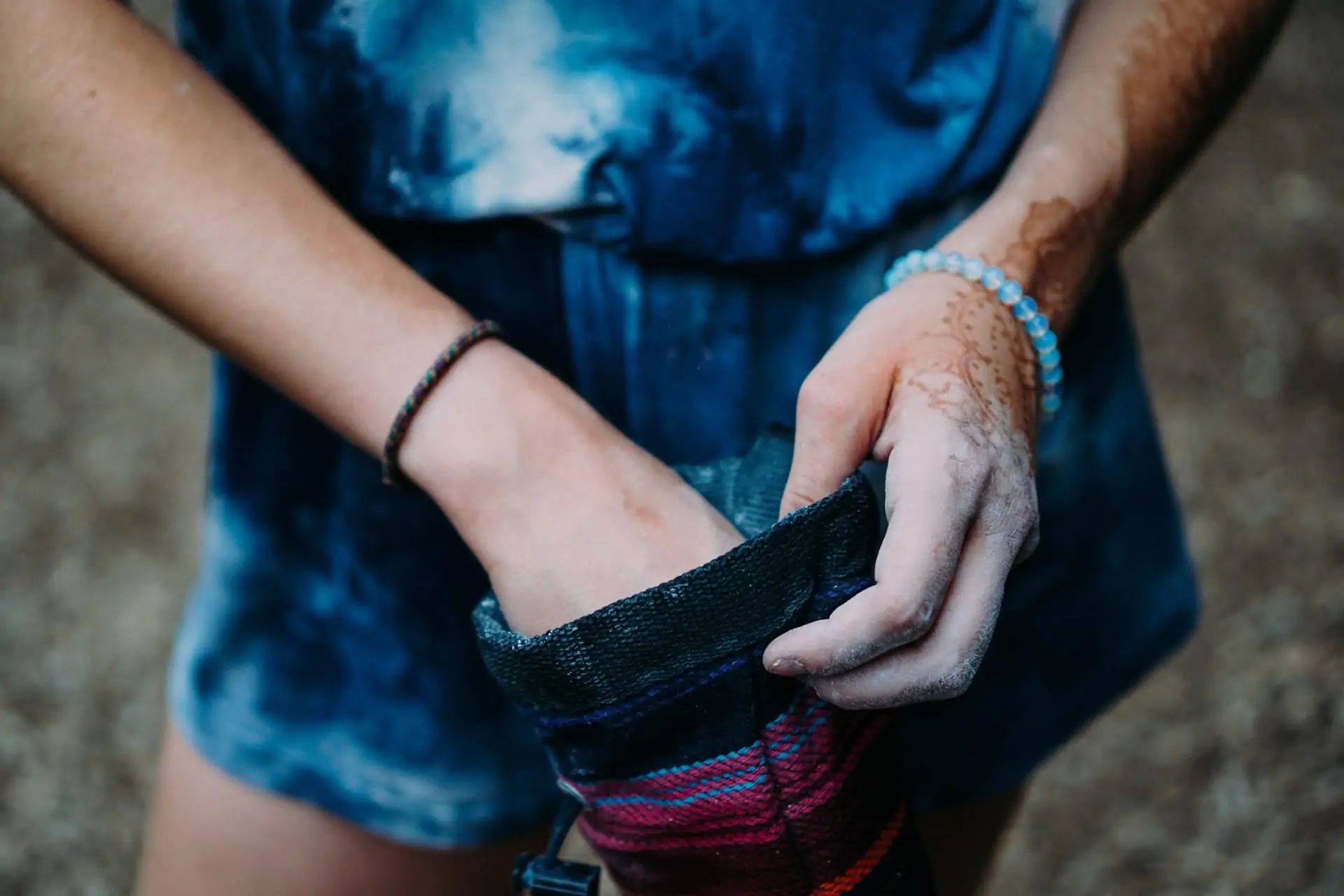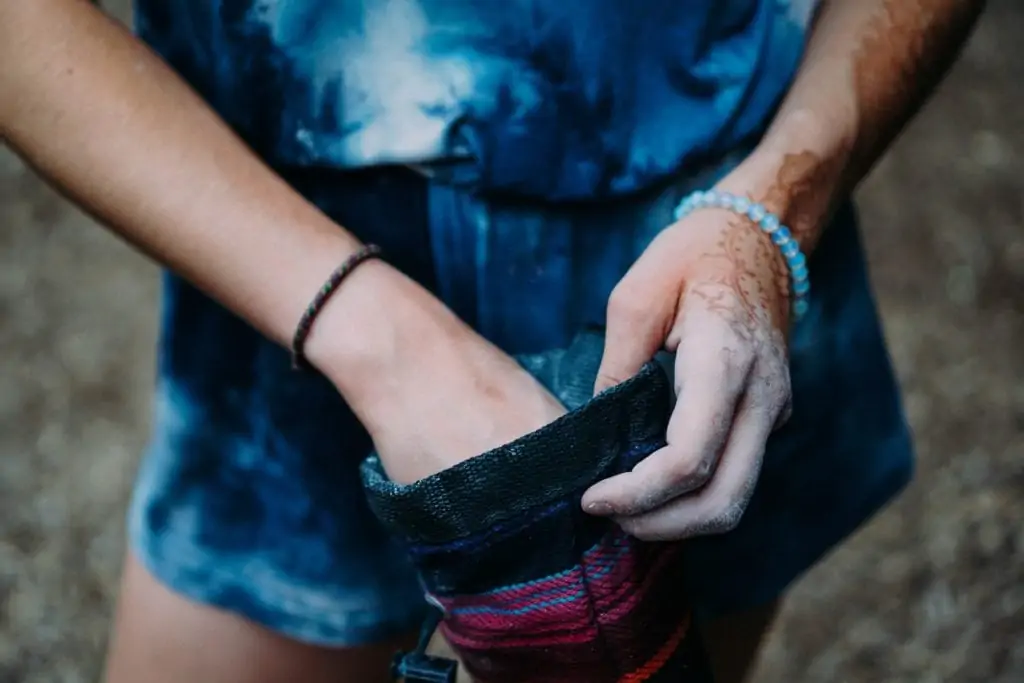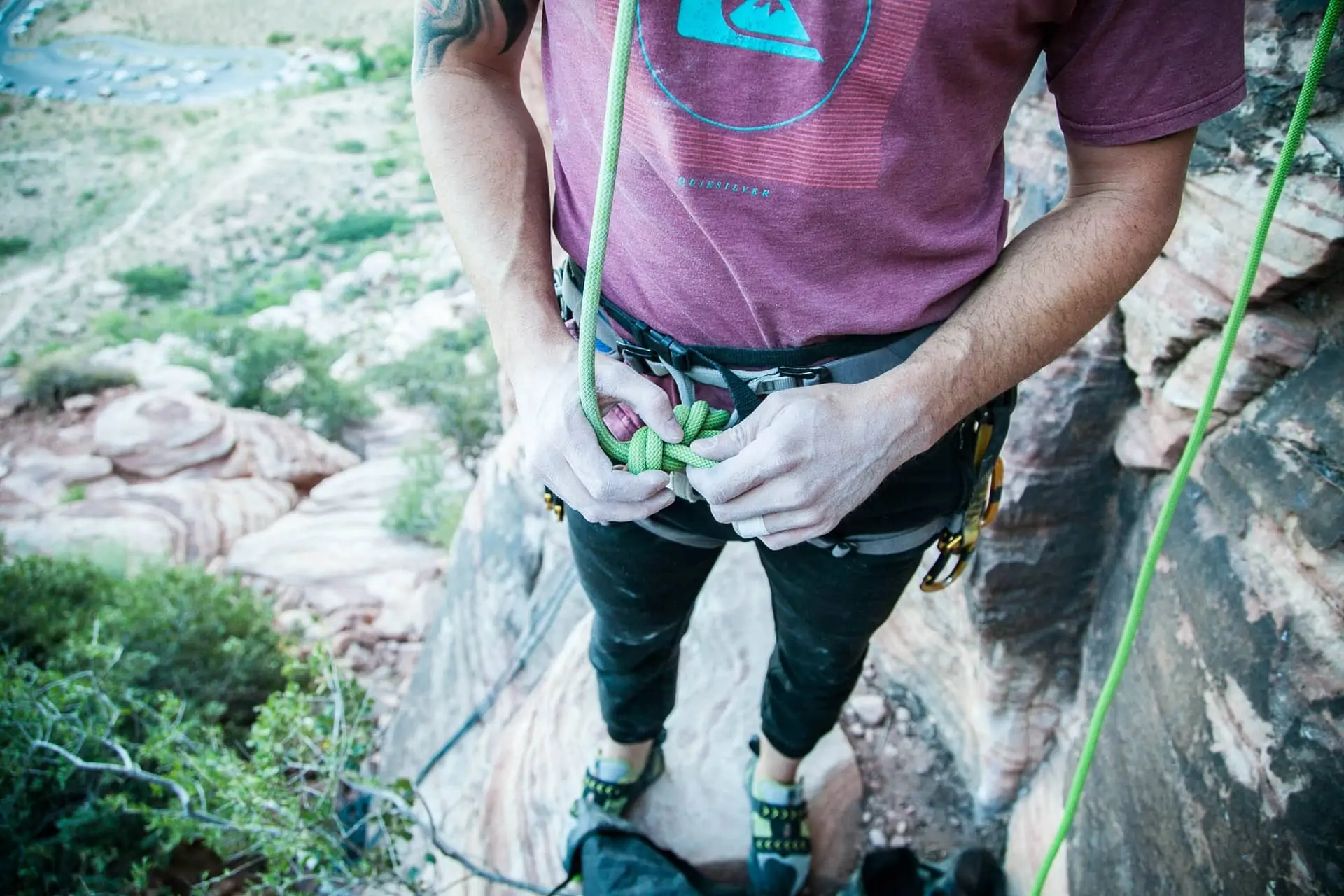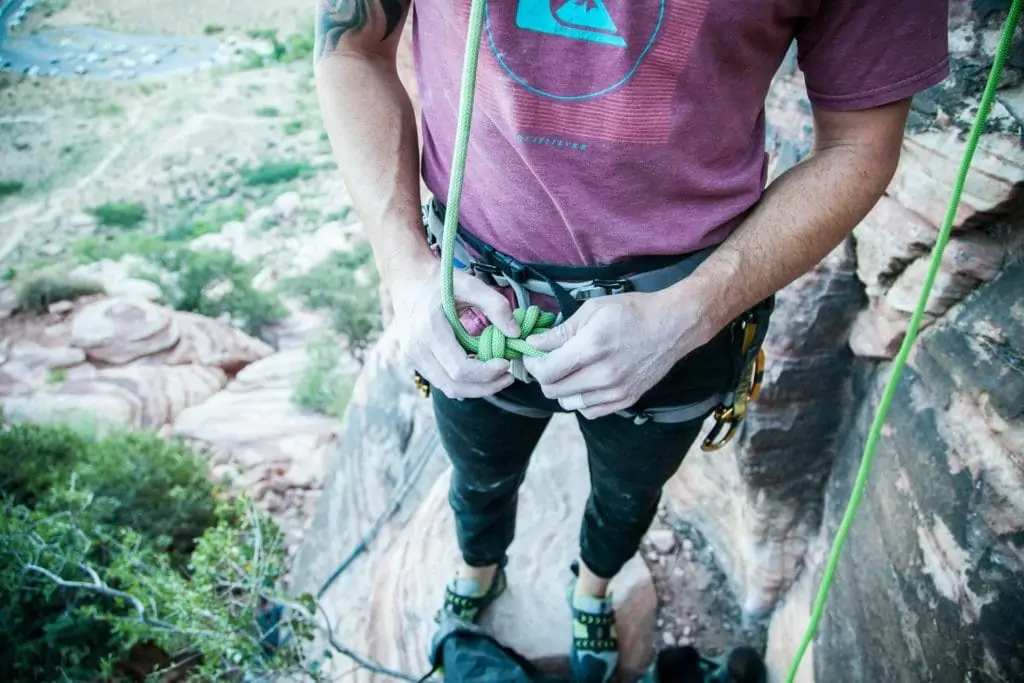Picture this: you’re halfway through the crux of a long climb. You reach up to the next crimp, but your starting to sweat from the effort. Just as you are about to reach up with your other hand, you feel your fingers begin to slip. Your hand slides off the crimp, your own sweat acting as a lubricant.
If you have ever had this situation, you’ve probably started using chalk pretty soon after to help dry out your hands and prevent slipping. Unfortunately, dry chalk, oftentimes in a powdered form, can be frustrating to keep reapplying and can get everything you’re wearing covered in a fine white powder. Recently, many climbing chalk companies have begun to make a liquid form of chalk to help combat some of the challenges of dry chalk.
 What is Liquid Chalk? How Does it Work?
What is Liquid Chalk? How Does it Work?
Liquid chalk is regular chalk, but in liquid form. Think of that white powder that is common at climbing gyms or gymnastics studios that people use to dry sweat off of their hands and increase their grip, but in liquid form.
Although we call it “liquid chalk” it often is more of a paste or gel consistency that can easily be spread across your hands, similar to how you would spread lotion on your skin. Something to note about liquid chalk is that it tends to look significantly more clear than dry chalk when you initially apply it. This can be off-putting to many people, but don’t worry. As the liquid evaporates, it leaves only the chalk residue, slowly turning your hands the normal chalky white color.
The primary ingredient is alcohol, which evaporates fast and dries out your hands. Many companies, such as FrictionLabs, are making options that are not alcohol-based, so your hands don’t dry out as much, but most are still alcohol-based. The liquid format allows you to spread the chalk evenly over your whole hand and the evaporation of the liquid as the chalk dries onto you helps pull moisture away.
There are many types of liquid chalk out there on the market now. Brands like Mammut, Petzl, and Friction Labs make some of the most popular types of liquid chalk, but finding the best type of liquid chalk for you may take some trial and error. There is no definitive “best” liquid chalk out there. It totally depends on the conditions under which you’re climbing.
What is Dry Chalk?
Dry chalk is what most climbers use. It comes in both powdered form and in block form, and is used to dry out your hands while climbing. It can be bought in a variety of powdered types, ranging from larger chunks to a fine white powder and everything in between. In general, it is predominantly made of Magnesium Carbonate, but is often supplemented with fillers and other additives to increase grip and lower the price.
Dry chalk is usually stored in a chalk bag that is either worn around your waist or in a larger chalk bag that sits on the ground. Applying dry chalk is simple, just reach your hands into the bag and cover them with as much or as little dry chalk as you want. This is the most common form of chalk found around climbing gyms and is often what is associated with climbing.
By the way, in case you’re looking for the best climbing chalk, we review our top picks here.
Is Liquid Chalk Better Than Regular Dry Chalk?
Liquid chalk can offer better coverage than dry chalk, but can dry out your hand significantly more. Many climbers say that liquid chalk lasts longer than dry chalk. Overall, the norm in climbing has been to use dry chalk, but liquid chalk has been gaining popularity, especially in terms of a base layer.
The main advantage of liquid chalk for many climbers is its ease of use and complete coverage of your hands. Lots of climbers like to start the day off with a layer of liquid chalk and supplement it with additional dry chalk throughout the day. If you’re wondering how long liquid chalk lasts, liquid chalk can last for many hours throughout a long day or climb, but the exact number of hours depends on where you are. If you’re climbing on a sea cliff, your liquid chalk may not last more than an hour, but if you’re climbing in a dry climate, liquid chalk may provide you an amazing base layer all through the day.
Because of the vast difference in performance between liquid and dry chalk, it is hard to say for sure which one is the best. Each type of chalk performs differently under different circumstances and you have to determine for yourself which chalk is best for you and when. Many people find that one style of chalk works for them in the gym or out bouldering, but they use a different type of chalk on long climbs. It all depends on what you want in your chalk.
Does Liquid Chalk Perform Differently?
Typically, liquid chalk lasts longer and provides a more even coverage of your whole hand than dry chalk does. Many climbers like to use both, starting off the day with a layer of liquid chalk and then using smaller amounts of dry chalk to supplement their chalk layer throughout the day or climb.
Liquid chalk is also known to continually dry out your hands, even after the initial application. Because of the alcohol base of most liquid chalks, they will continue to pull moisture off your hands and keep them dry for a long amount of time. Dry chalk tends to have a more one-time drying effect, but is easy to reapply as needed. It is also easier to only chalk up certain areas of your hands with dry chalk. Because liquid chalk is designed to be spread out, if you only want chalk on your fingertips, you may find it easier to use dry chalk.
What are Common Cons of Liquid Chalk vs. Dry Chalk?
Many climbers use dry chalk for its ease of application during a climb, but it wears off fast as you climb. It also tends to make quite a mess, leaving white chalky powder everywhere in your climbing bag. Dry chalk also releases lots of powder into the air that is not good to inhale, whereas liquid chalk won’t release any harmful dust for you to breathe in.
Liquid chalk is easier to transport, but it can dry your hands out a ton. This might seem like a pro, but for some people with naturally dry skin, it can be really frustrating to use. The alcohol base also irritates some people’s hands, so be careful the first time you try liquid chalk. Liquid chalk is also harder to reapply mid-climb, unless you want to carry the little bottle with you. Overall, liquid chalk has a variety of pros and cons, but combining liquid chalk with dry chalk is a well-loved chalk combo that will cover most situations.
Can You Travel with Liquid Chalk or Dry Chalk? What Does the TSA Say?
Liquid chalk comes in small tubes, similar to many cosmetics. According to the TSA requirements, you can bring 1-quart sized bag per passenger full of liquids, gels, and aerosols as long as they are smaller than 3 ounces. If liquid chalk is in a small enough container, it can be taken through security with your other liquids.
There is no rule that prevents you from flying with dry chalk, or any other climbing gear, as long as it isn’t sharp or could be used as a weapon. Leaving your chalk in its original packaging may get you less questions than a plastic bag of white powder and it may save you time and breath from explaining climbing chalk to the TSA agents.
You can also download the MyTSA app to check specific things that you can and cannot bring either in your carry-on or checked luggage. We checked for you and, as of now, their list does not include anything about climbing gear or chalk. They do have an option to contact TSA with questions, so if you’re really worried, we suggest asking TSA specifically.
Which Type of Chalk Dries Your Hands Out More?
Liquid chalk dries your hands out significantly more than dry chalk due to its composition. While dry chalk is mostly made up of Magnesium Carbonate, plus some fillers and drying agents to bring down the cost, liquid chalk is alcohol-based, meaning that it sucks the moisture out of your skin. There are some alcohol-free versions of liquid chalk that are on the market now. These alcohol-free versions are designed specifically to limit the excessive drying associated with liquid chalk and to prevent the negative reactions that some people have to the liquid chalk.
Do Pro Climbers Use Liquid Chalk or Dry Chalk?
Pro climbers are typically seen using mostly dry chalk, but that isn’t to say that they never use liquid chalk. Pro climbers usually project longer climbs and the easiest style of chalk to apply mid-climb is dry chalk.
Many pro climbers are also sponsored by Black Diamond, Petzl, La Sportiva, or any other climbing brand. This means that they are more likely to use a product, be it liquid or dry chalk, that their sponsor company makes. For example, many of Mammut’s Pro Team members swear by Mammut’s liquid chalk, but similar statements can be said for athletes sponsored by brands that specialize in dry chalk.
Wrapping Things Up: Key Takeaways from Liquid Chalk vs. Dry Chalk
Overall, the type of chalk that you use is not likely to be the defining factor in your growth and development as a climber.
If you find that you are struggling to apply an even layer of dry chalk, then maybe liquid chalk is for you.
If you have naturally dry hands, then maybe dry chalk is for you.
There is no one correct type of chalk for climbing. It’s all about experimenting with different types of dry chalk and liquid chalk to find what works best with your hands and for your climbing.
Did you enjoy this post? Then check out our guide to the best chalk here.
If you still need a bouldering bucket, check out our reviews of the best ones here.

 What is Liquid Chalk? How Does it Work?
What is Liquid Chalk? How Does it Work?










